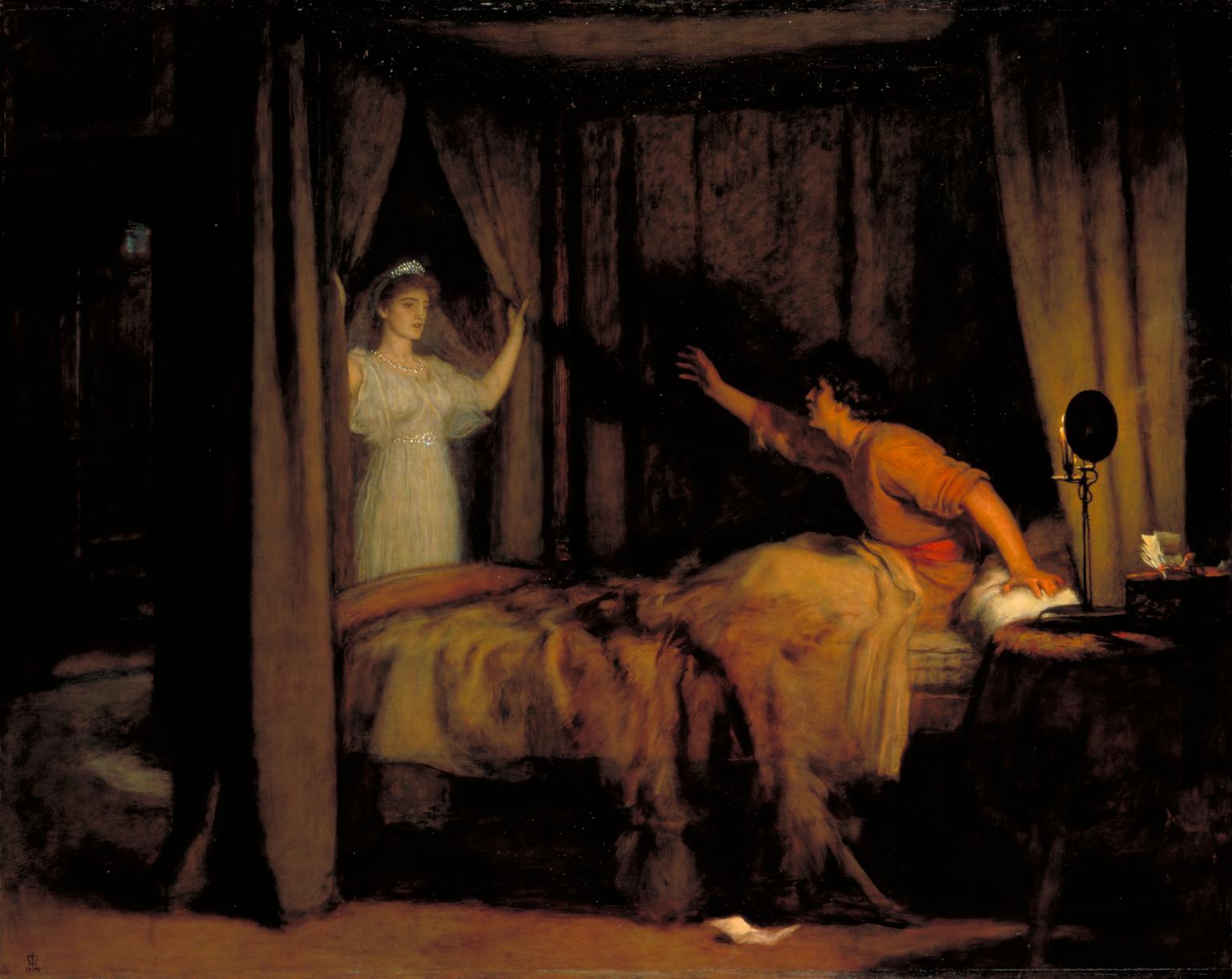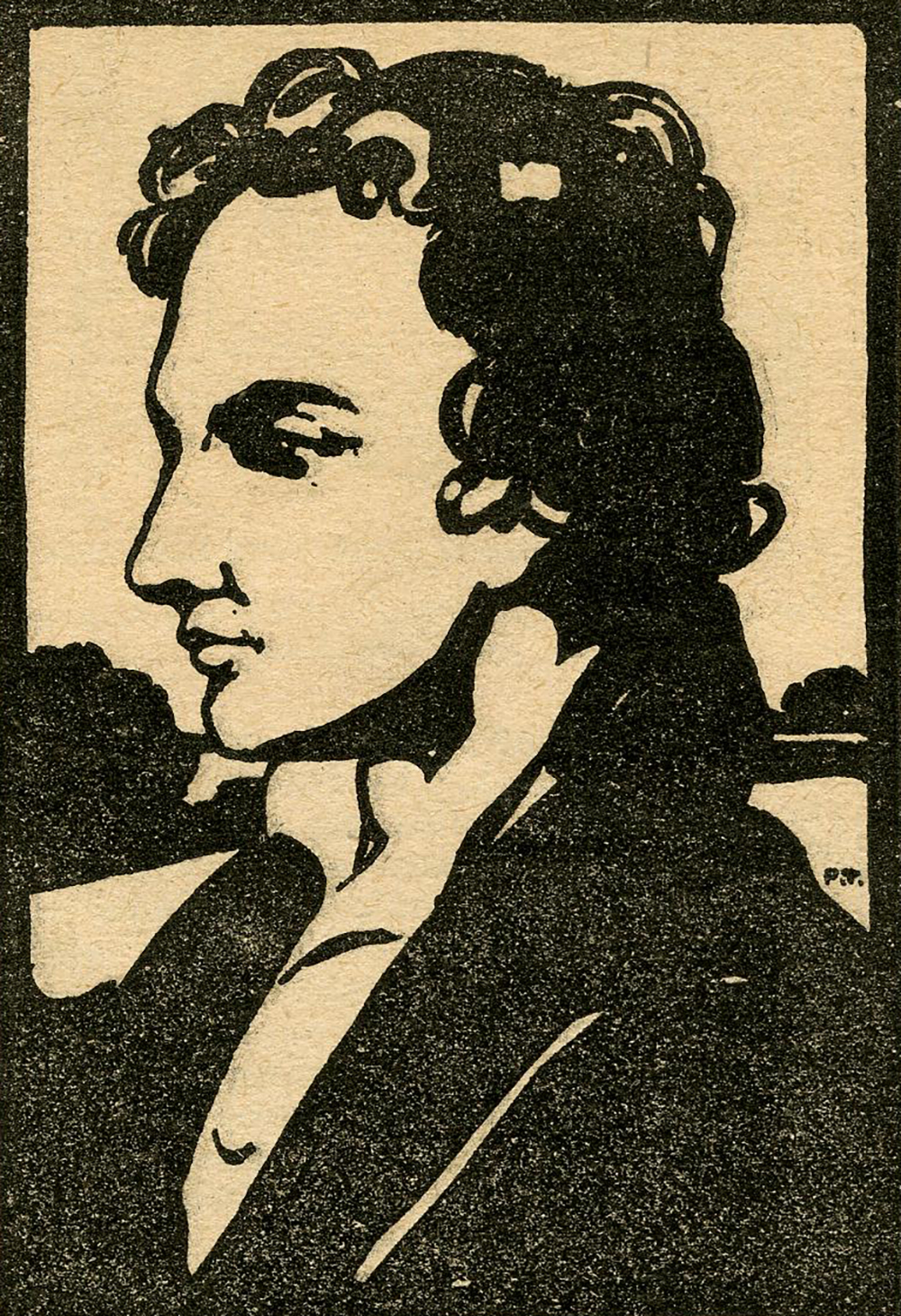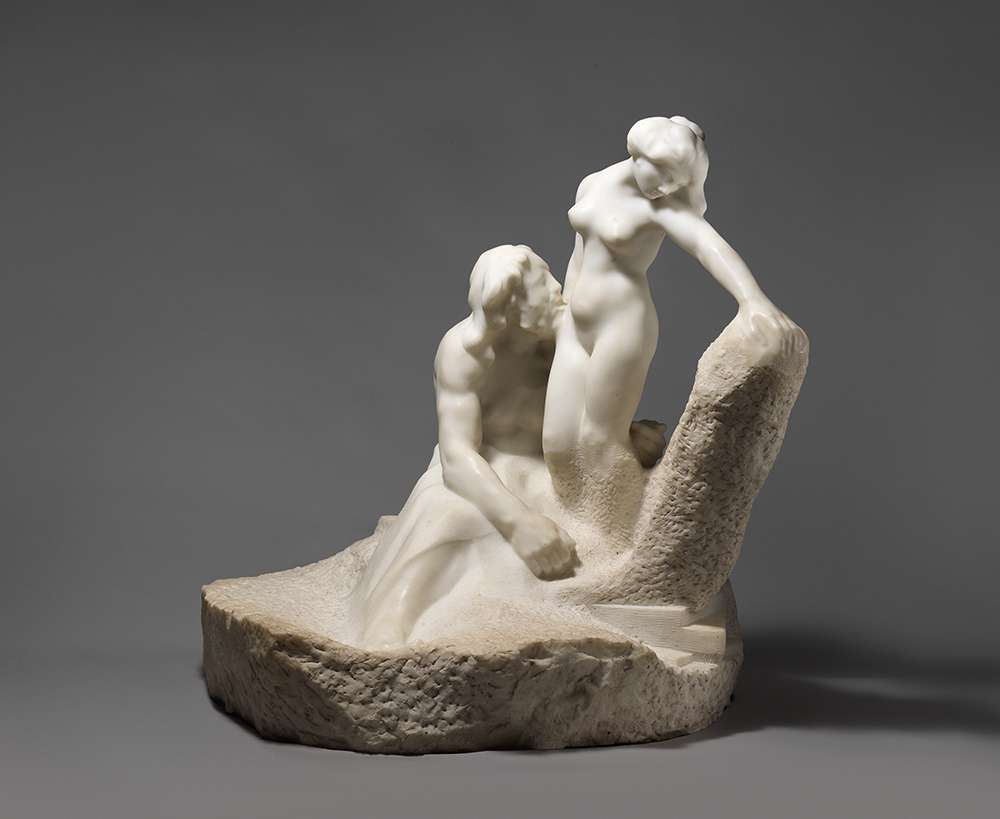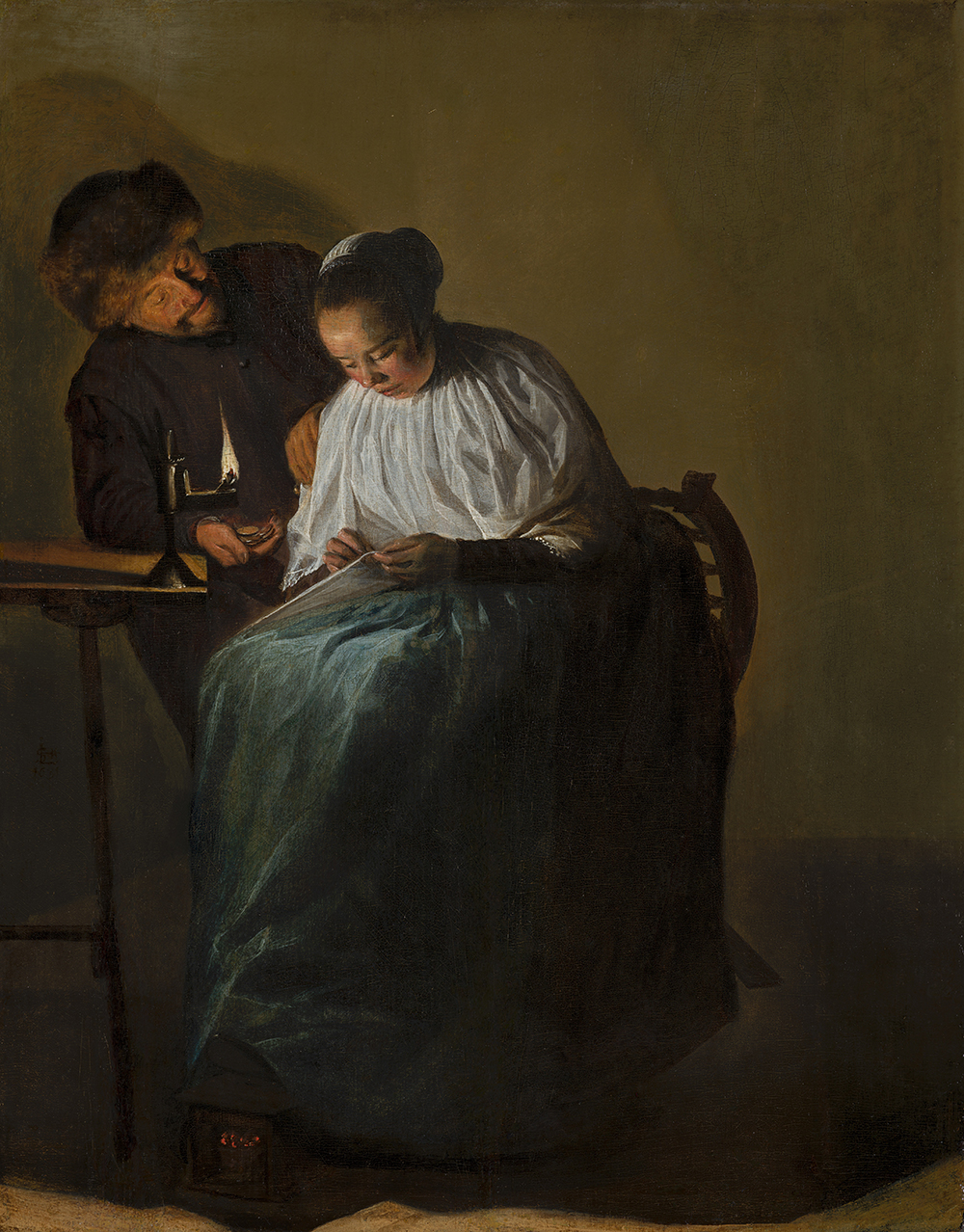
Speak! Speak!, by Sir John Everett Millais, 1895. Photo © Tate (CC BY-NC-ND 3.0).
In 1822 the English painter Robert Haydon wrote to the author Mary Russell Mitford that their mutual friend William Hazlitt “at present gives me great pain by the folly with which he is conducting himself”—a romantic obsession that Haydon was convinced “will be [Hazlitt’s] death” and Hazlitt regaled in detail to patrons of London’s coffeehouses, whether they wanted to hear it or not. Haydon wrote, “Hazlitt’s torture is beyond expression.” Another friend of Hazlitt’s, the poet Bryan Procter, wrote in his diary around the same time that Hazlitt “told the story of his attachment to five different persons in the same day.”
“I am a cursed fool,” he said to me. “I saw J— going into Will’s Coffeehouse yesterday morning; he spoke to me. I followed him into the house; and whilst he lunched, I told him the whole story. Then,” (said he), “I wander into the Regent’s Park where I met one of M[ontagu]’s sons. I walked with him some time, and on his using some civil expression, by God! sir, I told him the whole story.” Then he mentions another instance which I forget.
And so on. “This has a stamp of authenticity,” P.P. Howe wrote in his 1922 biography of Hazlitt, which quotes both Haydon’s and Procter’s accounts. Howe added that the story was further bolstered by “the circumstance that Hazlitt told it against himself, as he might have done in an essay.”
William Hazlitt was never one to suppress his feelings or abnegate his views. His literary achievement married the polite observational essay of Samuel Johnson and Joseph Addison with the ferocious pamphleteering of Jonathan Swift and Daniel Defoe. Combining worldly erudition and polemical passion had a destabilizing effect, wherein an essay on Wordsworth could detour suddenly into how “all country people hate each other…For not being accustomed to enjoyment, they become hardened and averse to it—stupid, for want of thought—selfish, for want of society.” It could birth provocative observations in which “a good-natured man is, generally speaking, one who does not like to be put out of his way” and where intellectual superiority is akin to “being moral in a night-cellar” and “wise in Bedlam.”
Hazlitt’s garrulous chaos won over few of his contemporaries, however. He was a compulsive arguer, socially tactless, impatient with fashionable or reactionary thinking. He was also intemperate in his feelings, which knew no kind of moderation, and utterly indifferent to decorum in making them public. He made enemies far more easily than friends, and those enemies then went on to make his life more difficult than he already made it himself. Public humiliation and ridicule in print were constant occurrences. “His was a uniquely unsublimated life,” writer and editor Ronald Blythe wrote in 1982. Hazlitt struggled to stay afloat by producing a constant stream of work for whatever magazines would publish him, raging against the “cant” of the day, and awkwardly intermingling self-promotion and self-sabotage. Hazlitt was the precursor to the modern freelancer, making noise to as many as could hear with the materials at his disposal: a vast erudition, unbending radical principles, and an eloquent but unaffected prose style.
But in 1822 Hazlitt appeared to be enacting a level of drama excessive even by his own standards. He was not so much exploding as he was collapsing into himself—and had been for two years running. It began when Hazlitt, in the censorious words of Haydon, fell “in love with a lodging-house hussy.” To this woman, as Procter put it, “he gave all his valuable time, all his wealthy thoughts, and all the loving frenzy of his heart. For a time, I think that on this point he was suitably insane”—perhaps an interesting choice of words, given Procter’s later work as a civil servant overseeing the not always diagnostically reliable asylum system.
Interest in the affair between William Hazlitt and the “hussy,” who was named Sarah Walker, has never waned. Assessments of Hazlitt usually mention it, even if only in passing. It was neither the first nor the most salacious scandal of the heart in literary history, and it isn’t even the first such scandal to entangle Hazlitt. His admirers’ explanations for his behavior vary between embarrassment and fascination even now. Hazlitt and Walker’s affair is remembered less for what happened than how it was conveyed after the fact by Hazlitt. The combative, candid author and the socially indelicate man often intersected in his essays. Yet his experience with Walker produced a work that makes those essays appear elusive and elegant, even conservative, by comparison.
In August 1820 William Hazlitt moved into 9 Southampton Buildings, a London lodging house owned by Maciah Walker, a tailor, and his wife, Martha. The forty-two-year-old writer had separated from his wife, Sarah Stoddart. The marriage, brought about by the matchmaking of Charles Lamb and his sister Mary, lasted twelve years and bore three children, but seemed to be one of tolerance and convenience more than of affection. Stoddart was three years Hazlitt’s senior, a fixture of the Romantic scene, and her husband’s equal in personal independence. “I should like to see you and Hazlitt come together,” Mary Lamb had written to Stoddart, “if (as Charles observes) only for the joke sake.”
Within a few days of Hazlitt’s arrival in London, the Walkers’ twenty-year-old daughter, also named Sarah but who sometimes went by Sally, came to his room to serve him breakfast. He fell in love on the spot. “When I sometimes think of the time I first saw the apparition,” Hazlitt later wrote, “and that possibly she may be my bride before that day [in] two years, it makes me dizzy with incredible joy and love of her.” He would remain in love for the next three years, bolstered in no small part by what he took to be his love object’s own inconsistent response to his feelings. His wooing was unsuccessful. But rather than move on, Hazlitt committed the ordeal to paper. His account of the affair was published in the short book Liber Amoris: or, The New Pygmalion, which was released only a year after his divorce was finalized in 1822. Much of the text was written in or en route to and from Scotland, where he established partial residency to take advantage of the nation’s more lenient divorce laws. Hazlitt’s deluded intention of marrying Walker as soon as he was single, a proposal she refused, fueled the entire project.

Liber Amoris is less known to casual readers of Hazlitt than his essays. For one, it is not widely available. The most recent popular edition takes up eighty-five pages of an out-of-print Penguin Classics anthology of Hazlitt’s work, edited by Blythe and published in 1982. The book is also difficult to describe: it is fiction but contains barely veiled, though one-sided, truth. It is a novel without a narrative; it is idiosyncratic but familiar; it is a love story in which nothing really happens, yet is cruel to the object of that love. Since it first appeared, it has also been subject to the strongest vitriol. Writing a month after its 1823 publication, diarist Henry Crabb Robinson called it “disgusting” and said it “ought to exclude the author from all decent society.” Robert Louis Stevenson had once planned to write a biography of the writer he appointed as his hero. “I am a fervent Hazlittite,” he wrote to a friend in 1881, “I mean regarding him as the English writer who had the scantest justice.” He never wrote it, and it is speculated that he discovered Liber Amoris and, in the words of Blythe, “withdrew in horror.”
Liber Amoris first appeared anonymously, with a preface stating that its author had “left his own country early in life, in consequence of political animosities and an ill-advised connection in marriage,” only to die “soon after in the Netherlands…of disappointment preying on a sickly frame and morbid state of mind.” Yet Hazlitt’s pen was easy to detect. He reused his own letters about Sarah Walker and talked about his infatuation in great detail to anyone who would listen right before the book’s publication. Still more laughable was his insistence that “the names and circumstances are so far disguised…as to prevent any consequences resulting from its publication, farther than the amusement or sympathy of the reader.” (That or is doing a lot of work.)
It is remarkable how little Liber Amoris goes out of its way not to disprove Procter’s assertion that Hazlitt was suitably insane. The text is marked by the narrator’s complete eschewal of rational thought or self-awareness, held together only by the certainty of his intuitions. But the extent of its sincerity, or how transparent the text truly is, has long been a matter of debate.
Liber Amoris at the outset appears to be something like the offspring of the previous century’s epistolary romances, namely Rousseau’s Julie (which Hazlitt greatly admired) and Goethe’s The Sorrows of Young Werther. Like Julie, Hazlitt’s book borrows from the author’s own romantic disappointments in pursuit of an ideal. Like Werther, it does not shy away from the immense emotional costs exacted by the protagonist’s intense unrequited love. And like both, it is infused with the musical and intuitional cadences of a love letter.
But the offspring rebels from its parents in significant ways. Liber Amoris has no interest in the moral sentiments that Rousseau sought to articulate in Julie, and, despite the death of the protagonist announced at the start, it avoids the acutely dire consequences that Goethe served Werther. What Hazlitt gives us is something wilder than these earlier best sellers, something with less dignity and less accessibility.
The book opens with seven dialogues between H (Hazlitt) and S (Sarah Walker). Though little context is provided and the passage of time is murky, this is presumably a sequential procession of their acquaintance in miniature, almost like a highlight reel. Mostly it establishes the pitch of Hazlitt’s rhetoric: “Your power over me,” he tells S, “is that of sovereign grace and beauty. When I am near thee, nothing can harm me…But when I let go thy hand, I stagger on the precipice: out of thy sight the world is dark to me and comfortless.” It also establishes the palette of his emotions, which are unstable but limited in range. He is as full of jealousy and suspicion as he is full of adoration, and can shift from one to the other and back again very quickly. “Have you two characters, one that you palm off upon me, and another, your natural one, that you resume when you get out of the room, like an actress who throws aside her artificial part behind the scenes?” he demands. A particularly unsubtle detail is a picture he gives Sarah; when she asks him to tell her what it is, he replies, “Hardly I know; but it is a very small and delicate copy…of some fine old Italian picture, Guido’s or Raphael’s, but I think Raphael’s. Some say it is a Madonna; others call it a Magdalen.” For H, love was more a matter of creation than emotion. Mere affection, in fact, seemed trivial. Love was the medium on which to render H’s obsession, using a boardinghouse servant as his material.

This section is the only part where the love object’s voice is directly heard. Even then we hear very little—to most of Hazlitt’s polysyllabic reveries and accusations, she sends back only the most curt, formal replies.
H. If you would consent to bear me company, I would swear never to think of an Italian woman while I am abroad, nor of an English one after I return home. Thou art to me more than my whole sex.
S. I require no such sacrifices.
H. …But sacrifices are no sacrifices when they are repaid a thousandfold.
S. I have no way of doing it.
H. You have not the will.—
S. I must go now.
This section establishes the basic emotional framework of Liber Amoris. H’s Pygmalion seems at first like a failure. But rather than disillusion himself from the ideal and back to the flesh-and-blood woman out of which it was fashioned, he just compounds the illusion. The Pygmalion becomes something closer to a rebel, if not an antagonist. And H has only begun to press his case.
The next two sections consist of his letters to friends, author Peter George Patmore and dramatist James Sheridan Knowles. First he is in Scotland, “on my probation,” he writes to Patmore. “I have been in a sort of purgatory.” Elsewhere he writes that “she has shot me through with poisoned arrows, and I think another ‘winged wound’ would finish me.” To Patmore again: “Your letter raised me a moment from the depths of despair; but not hearing from you yesterday or today (as I hoped) I have had a relapse.”
In an earlier essay about the “familiar style,” defending the conversational prose that had brought him renown, Hazlitt wrote, “It is easy to write in a gaudy style without ideas, as it is to spread a pallet of showy colors, or to smear in a flaunting transparency.” Disregarding his own advice in Liber Amoris is at once a show of audacity and often a great annoyance to the reader. For he is right that gaudiness clouds ideas—Liber Amoris is a document of undiluted feeling, predominantly agony.
I am now enclosed in a dungeon of despair. The sky is marble to my thoughts; nature is dead around me, as hope is within me; no object can give me one gleam of satisfaction now, nor the prospect of it in time to come…I have lost the taste of my food by feverish anxiety; and my favorite beverage…has no moisture in it. Oh! cold, solitary, sepulchral breakfasts.
He directs one letter to the entire city of Edinburgh:
Edinburgh! What art thou to me? The dust of thy streets mingles with my tears and blinds me. City of palaces or of tombs—a quarry, rather than the habitation of men!…Thy cold gray walls reflect back the leaden melancholy of the soul. The square, hard-edged, unyielding faces of thy inhabitants have no sympathy to impart.
The third section is far more dejected in mood, opening with “it is all over, and I know my fate.” Having finalized his divorce in Scotland, H has returned to 9 Southampton Buildings to repair what may remain of his relationship with S and again try to carry it further. His success is unlikely, but he remains wholly enamored: “Her whole attitude, her whole form, was dignity and bewitching grace. ‘You look like a queen, my love, adorned with your own graces!’”
I grew idolatrous, and would have kneeled to her. She made a movement as if she was displeased. I tried to draw her toward me. I then got up and offered to kiss her in parting. I found she obstinately refused. This stung me to the quick…There must be some new bar between us to produce these continued denials; and she had not even esteem enough left to tell me so. I followed her halfway downstairs, but to no purpose, and returned into my room, confirmed in my most dreadful surmises. I could bear it no longer, I gave way to all the fury of disappointed hope and jealous passion. I was made the dupe of trick and cunning, killed with cold, sullen scorn; and, after all the agony I had suffered, could obtain no explanation why I was subjected to it.
In his failure, Hazlitt’s idolatry evaporates almost as if it never existed, giving way to an eruption that shatters the peace of the house and destroys another small painting gifted to Sarah, of his other great obsession, Napoleon Bonaparte.
I tore the locket which contained her hair (and which I used to wear continually in my bosom, as the precious token of her regard) from my neck, and trampled it in pieces. I then dashed the little Bonaparte on the ground, and stamped upon it, as one of her instruments of mockery. I could not stay in the room; I could not leave it; my rage, my despair were uncontrollable. I shrieked curses on her name, and on her false love; and the scream I uttered (so pitiful and so piercing was it, that the sound terrified me) instantly brought the whole house, father, mother, lodgers and all, into the room. They thought I was destroying her and myself.
Hazlitt was constantly envious of other male guests being more intimate with Walker. His fears were confirmed on his return to London. Called Mr. C in the book, John Tomkins was a lawyer and fellow lodger. Upon seeing her on the street, Hazlitt writes:
I felt a strange pang at the sight, but I thought her alone. Some people before me moved on, and I saw another person with her. The murder was out. Would you believe it, after all that had passed between us for two years, after what had passed in the last half year, after what had passed that very morning, she went by me without even changing countenance, without expressing the slightest emotion, without betraying either shame or pity or remorse or any other feeling that any other human being but herself must have shown in the same situation.
Only a few sentences earlier he had resolved to “make her my wife.” Instead Walker married Tomkins and lived an unremarkable life until her death in 1878. Hazlitt remarried in 1824 to a widow named Isabella Bridgwater. Bridgwater seemed infatuated with Hazlitt’s fame, while Hazlitt was primarily attracted to the £300 annuity (£36,000 today, adjusted for inflation) she had inherited from her previous husband. They separated in 1827. He went on to publish his best-known essays and a less well remembered four-volume biography of Napoleon. He met Stendhal in Paris, and upon his return to London he died of cancer at the age of fifty-two, in a boardinghouse that was later renovated as the luxury hotel Hazlitt’s.
Liber Amoris was treated mostly as gossip upon its publication, with the media least sympathetic to Hazlitt’s radical politics relishing it the most. The Times revealed Hazlitt’s authorship; John Bull magazine published one of his letters to Walker, who was not spared her own public scrutiny. The press labeled her a “poor half harlot” and a “dowdy trollop,” among other things.
How Walker herself reacted to this attention, let alone how she saw her relationship with Hazlitt, is not known. Her silence, apart from what Hazlitt wrote that she said, is conspicuous. In 2000 Charles Nicholl attempted to fill that gap for the London Review of Books. He describes their affair as an “idealized, erotic stalemate.” Walker’s exact feelings remain subject to speculation, limited to “the standard coquetry of the situation.” It was not out of keeping for a female servant in “a middle-market London lodging house” to offer “sexual favors (‘liberties’) to the gentlemen upstairs, who are thereby disposed to stay longer and complain less.” As such, Hazlitt suspected Walker of being a “decoy, played off by her mother upon the lodgers, one after another.” “Whether Sarah went ‘all lengths’ with any of the lodgers is another matter,” Nicholl wrote. “It is not necessary to believe she did…Despite the dark suspicions of Hazlitt, and the casual aspersions of many since, it is likely she was still a virgin.”
He adds that “one of the grating assumptions of the Liber Amoris, unthinkingly adopted by the majority of biographers, is that he was the exploited…and she the exploiter.” This tendency to take sides, as gossipers often do, is a futile endeavor. Not even Hazlitt’s own text is fully partisan, expressing the utmost affection for Sarah Walker while also acknowledging the lack of reciprocation. We are left with the fluctuations of Hazlitt’s mind between perception and reality.

It’s worth considering the possibility that Hazlitt’s true foil was not Sarah Walker but Sarah Stoddart. Unlike Patmore, Knowles, and anyone else her husband tried to rope into his drama, Stoddart maintained some semblance of independence from the ordeal. When free of legal proceedings, she set off to explore Scotland on foot, walking some 150 miles of it, and kept a diary of her travels. “Neither lover nor homemaker,” Blythe wrote, “she was yet what [Hazlitt] vaguely wanted a woman to be—a free agent, an untrammeled soul. Sarah Hazlitt was…a New Woman born a century before her time.” Liber Amoris is less a standalone account of disastrous, unrequited infatuation than half of an account of the final, inevitable dissolution of an unusual marriage.
The embarrassing details of Liber Amoris have made the book’s merits as a creative work a secondary consideration at best. One of Hazlitt’s few supporters was Thomas De Quincey, an occasional rival essayist who was no stranger either to impassioned, confessional prose or public scandal. Though Liber Amoris was “universally laughed at,” De Quincey wrote, the book “greatly raised him in my opinion, showing him to be capable of stronger and more agitating passions than I believed to be in the range of his nature.”
De Quincey would be in the minority. The philosopher A.C. Grayling, who unlike Stevenson did manage to write a biography of Hazlitt, admitted that the work is “repulsive to any reader who does not know the story…and unbearably poignant to anyone who does.” In her biography of De Quincey, Frances Wilson claimed it is “one of the strangest books ever written,” but that both understates and deepens its oddity. It is usually of greatest interest to scholars, though the text and its back story have been reimagined in novels and even a 1977 British television movie, Hazlitt in Love, with Kenneth Haigh in the titular role.
“The incident of the infatuation for Sarah Walker is characteristic of Hazlitt the man,” editor William Marion Reedy wrote in his introduction to a 1908 edition of the work, “but its recital in the Liber Amoris is not essential to the full understanding of Hazlitt, the essayist and the critic.” It’s the eloquent candor of Hazlitt’s essays that takes precedence over the emotional discharge of Liber Amoris. The essays work. Even now they exemplify a high standard of the form and of the language in which they were written. By that standard, Liber Amoris does not. Or rather, it works in the same way a jar-encased sideshow attraction works: less to be comprehended than to be gawked at with perverse awe. It is awkward and prurient, rather tedious to read in long stretches, and it offers no humanistic edification to be mined compared to anything else Hazlitt has written. It certainly resists inspirational quotation, say, for the Instagram page of Hazlitt’s namesake hotel.
Yet those traits in turn make Liber Amoris hard to ignore. The work, as Reedy put it, “comes near to being a great burlesque of love,” at once “authentic” and “maudlinly distorted” with “a half-suspect sense of caricature in the writer.” Hazlitt’s humor was never his strong suit, but two centuries later, readers can pick up what could be the formation of a now prevalent effect: an intersection of comedy and dread in witnessing the self-destruction of another, where neither the ability nor the desire to prevent it are in evidence. The burlesque of the 1820s is the cringe comedy of 2020s. Hazlitt’s torrential shamelessness attracts our voyeuristic curiosity to a degree that approaches a kind of glee, even as we recoil in the knowledge that at any point the roles could reverse—but for the unavoidable reality admitted by Robert Louis Stevenson that, whether at our own best or worst, “we cannot write like Hazlitt.”